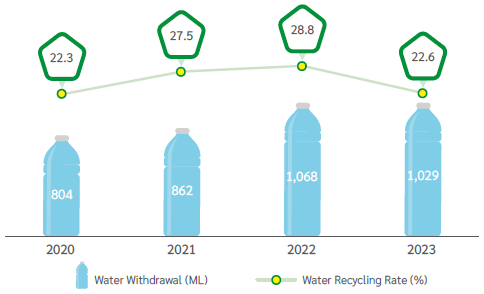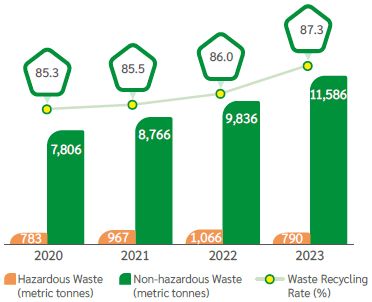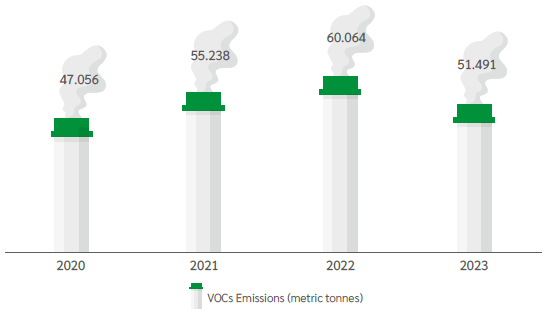
Environmental Protection and Occupational Safety
Pollution Control
USI has listed the use of resources and the reduction and reuse of waste as company policies. It adheres to the principles of "pollution prevention, continuous improvement" and "energy conservation, waste reduction, and effective use". All factories implement it and list it as a company policy. Annual performance indicators. Therefore, relevant units such as manufacturing processes, factory affairs, and environmental safety strictly monitor usage and output in accordance with local regulations and through regular data recording and tracking, and strengthen effective management and control of water resources and waste.
USI does not have issues with contaminating catchment areas as our facilities are not built around it. But Mainland China's regulation has become increasingly rigorous and parent company paid close attention, the storage and distribution of water resources have also become an important topic for us. USI strives to conserve water in manufacturing and everyday life by installing water meters and monitoring monthly water usage data to manage water resources and identify opportunities for conservation. Apart from regularly tracking the water consumption of the seven major manufacturing facilities to be added in Vietnam in 2023, each facility will separate and collect process chemicals for treatment, set up discharge water treatment facilities for water quality management, and regularly outsource the testing of discharge water quality to prevent the occurrence of incidents of contamination of water sources. Each facility is required to conduct tests in accordance with local laws and regulations.
In order to make full use of water resources, USI has enhanced the reuse of water resources by improving equipment and technology. USI's total water consumption in 2023 will be 1,028.62 million liters, a decrease of 3.7% from 2022 (1,068.17 million liters), which is water intensive. The water consumption rate dropped by 19.8% compared with 2015, achieving the water saving target. In addition, the recycled water volume was 232.94 million liters, with a total recovery rate of 23%, and the process water consumption was 188.94 million liters, with a process water recovery rate of 64%.

USI considers "Waste Minimization and Reuse" as corporate policy. The principles of "Impact Mitigation & Continuous Improvement" and "Effective Reduction & Circular Reuse" have been carried out thoroughly in all the facilities and treated as annual performance indicator. Therefore, through regular data record and tracking, the relevant units such as process unit, facility affairs unit, and EHS unit strictly monitor the usage and outputs, and strengthen the effective control of waste.
The total amount of waste generated in 2023 was 12,377 metric tonnes, and recycled 10,805 metric tonnes, with a recycling rate of 87.3%. Although it is a slight increase from the previous year, it still meets the annual target (80%); The non-hazardous waste recycling rate of 91.5% also meets the annual target (90%), the details are shown as follows. The hazardous waste generation intensity is 0.104 (kg/K USD) in 2023 and 0.114 (kg/K USD) in 2022, a decrease of 8.6% from the previous year.

In recent years, air pollution is getting worse in Mainland China and Taiwan. It seriously affected the quality of life for residents that become an urgent issue. This is the reason that local authority has made relevant amendments to local regulations. As our production facilities are within the affected areas, we also pay great attention to air pollutant control within our facilities.VOCs emissions in 2023 will be 51.49 metric tons, a decrease of 14.3% from the previous year. The overall emissions of VOCs have gradually been reduced.

For NOx, SOx, and PM emissions, since 2019, in order to reduce the emissions of NOx in the boiler exhaust gas, the Jinqiao Plant has carried out boiler exhaust gas transformation and equipped with a low-nitrogen burner. Starting from 2023, the Mexican factory will also comply with the requirements of local authorities and conduct testing for fine suspended particles. In the future, in addition to launching relevant information disclosure in other facility areas, we will also actively promote the expansion of relevant improvement measures to other factory areas to reduce the environmental impact caused by air pollution emissions. The air pollutant emission data in 2023 is shown in the following table:
| Pollutant | Zhangjiang | Jinqiao | Huizhou | Kunshan | Nantou TT |
Nantou NK |
Mexico | Vietnam |
|---|---|---|---|---|---|---|---|---|
| Volatile Organic Compounds (VOCs) | 2.455 | 1.946 | 2.316 | 1.186 | 15.559 | 28.029 | N/A | N/A |
| Nitrogen Oxides (NOx) | 0.770 | 0.388 | N/A | N/A | N/A | 1.559 | N/A | N/A |
| Sulfur Oxides (SOx) | N.D. | 0.002 | N/A | N/A | N/A | 0.668 | N/A | N/A |
| Particulate Matter (PM) | 0.270 | 0.224 | 0.057 | 0.241 | 1.950 | 0.420 | 1.180 | N/A |
Note: N/A: No applicable local regulation and no available self-testing data.; N.D.: Non-Detectable, the level is too low to be detected by the instrument.


